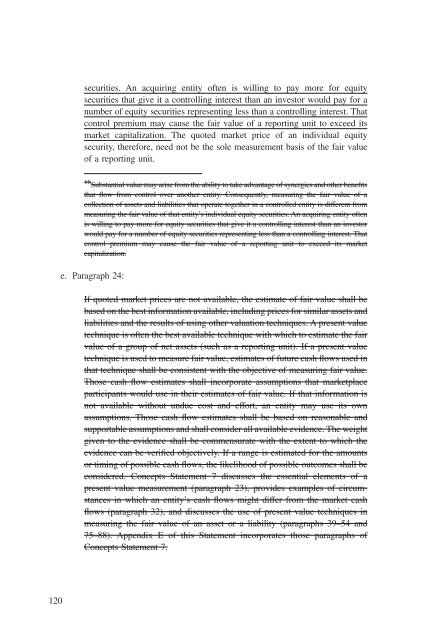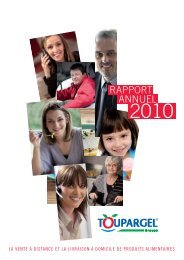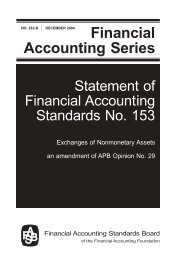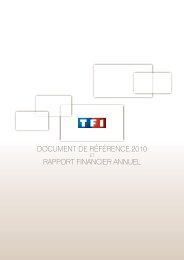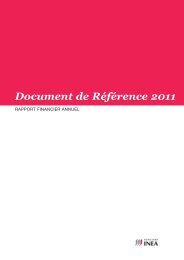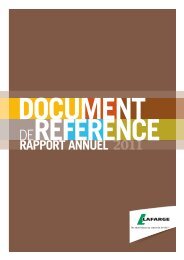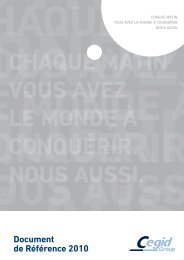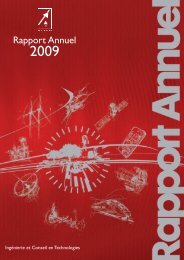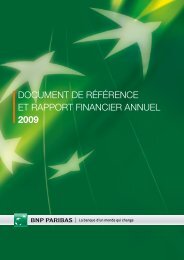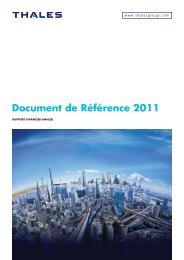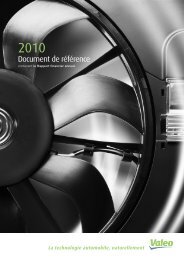Statement of Financial Accounting Standards No. 157 - Paper Audit ...
Statement of Financial Accounting Standards No. 157 - Paper Audit ...
Statement of Financial Accounting Standards No. 157 - Paper Audit ...
You also want an ePaper? Increase the reach of your titles
YUMPU automatically turns print PDFs into web optimized ePapers that Google loves.
securities. An acquiring entity <strong>of</strong>ten is willing to pay more for equity<br />
securities that give it a controlling interest than an investor would pay for a<br />
number <strong>of</strong> equity securities representing less than a controlling interest. That<br />
control premium may cause the fair value <strong>of</strong> a reporting unit to exceed its<br />
market capitalization. The quoted market price <strong>of</strong> an individual equity<br />
security, therefore, need not be the sole measurement basis <strong>of</strong> the fair value<br />
<strong>of</strong> a reporting unit.<br />
16 Substantial value may arise from the ability to take advantage <strong>of</strong> synergies and other benefits<br />
that flow from control over another entity. Consequently, measuring the fair value <strong>of</strong> a<br />
collection <strong>of</strong> assets and liabilities that operate together in a controlled entity is different from<br />
measuring the fair value <strong>of</strong> that entity’s individual equity securities. An acquiring entity <strong>of</strong>ten<br />
is willing to pay more for equity securities that give it a controlling interest than an investor<br />
would pay for a number <strong>of</strong> equity securities representing less than a controlling interest. That<br />
control premium may cause the fair value <strong>of</strong> a reporting unit to exceed its market<br />
capitalization.<br />
e. Paragraph 24:<br />
If quoted market prices are not available, the estimate <strong>of</strong> fair value shall be<br />
based on the best information available, including prices for similar assets and<br />
liabilities and the results <strong>of</strong> using other valuation techniques. A present value<br />
technique is <strong>of</strong>ten the best available technique with which to estimate the fair<br />
value <strong>of</strong> a group <strong>of</strong> net assets (such as a reporting unit). If a present value<br />
technique is used to measure fair value, estimates <strong>of</strong> future cash flows used in<br />
that technique shall be consistent with the objective <strong>of</strong> measuring fair value.<br />
Those cash flow estimates shall incorporate assumptions that marketplace<br />
participants would use in their estimates <strong>of</strong> fair value. If that information is<br />
not available without undue cost and effort, an entity may use its own<br />
assumptions. Those cash flow estimates shall be based on reasonable and<br />
supportable assumptions and shall consider all available evidence. The weight<br />
given to the evidence shall be commensurate with the extent to which the<br />
evidence can be verified objectively. If a range is estimated for the amounts<br />
or timing <strong>of</strong> possible cash flows, the likelihood <strong>of</strong> possible outcomes shall be<br />
considered. Concepts <strong>Statement</strong> 7 discusses the essential elements <strong>of</strong> a<br />
present value measurement (paragraph 23), provides examples <strong>of</strong> circumstances<br />
in which an entity’s cash flows might differ from the market cash<br />
flows (paragraph 32), and discusses the use <strong>of</strong> present value techniques in<br />
measuring the fair value <strong>of</strong> an asset or a liability (paragraphs 39–54 and<br />
75–88). Appendix E <strong>of</strong> this <strong>Statement</strong> incorporates those paragraphs <strong>of</strong><br />
Concepts <strong>Statement</strong> 7.<br />
120


